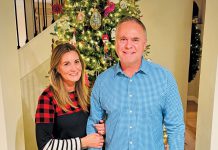
I attended the first San Francisco 49er home game of the season thanks to my Aunt Rosemary. I’m a Niner faithful, but it sure is fun to be on the winning side after so many years. At the football stadium, everything seems bright and colorful. I’m always amazed at how lush and green the field looks. How do they do that?
If you have a small lawn, you can appreciate how the caretakers at Candlestick Park accomplish this. Be grateful you don’t have 110,000 square feet of grass that is replaced annually.
In some years, due to inclement weather or abnormal wear and tear, the sod may be completely replaced a second time near the end of the football season.
Grounds crew members mow the field every day to encourage the grass to continue growing and remain vigorous. They fertilize about every 10 days.
The sod they use is called Tiffway II Bermuda, which is a hybrid of bermuda with perennial rye.
The 49ers will be moving to a new stadium in Santa Clara next year, and it also will have a natural grass field. Green technology will be a top priority. The landscape and field will be irrigated with recycled water, and green rooftops will be constructed on some of the suites. I don’t know now which type of turf they will plant, but it’ll be interesting to see what they choose.
Keep a healthy lawn
At your own home, fall is the best time to feed your lawn for winter hardiness and robust growth come spring. Grass stores nutrients in the roots to carry it over the winter months, so apply a generous application of organic lawn fertilizer. Your lawn will also need the phosphorus to encourage deep, strong roots for winter.
Over time, soil becomes compacted, especially is areas that get heavy use. Consider aeration to open up the spaces in the lawn to allow water, nutrients and air to get to the roots, making it thicker and healthier. It also helps drainage and water runoff.
There are aerators for every size job; just make sure it’s a core aerator that removes the core of soil rather than just punching narrow holes in the ground.
Once aeration is complete, it’s the perfect time to top-dress the lawn with a half-inch of organic compost.
Seed to fill gaps
If you can see patches of bare soil in your lawn, it needs to be over-seeded, and fall is the perfect time to do this. Over-seeding helps make lawns full and dense, keeps weeds down and helps prevent disease.
First remove any thatch — that layer of dead grass and debris that settles on the soil. To loosen the thatch, use a stiff-tined rake or rent a power de-thatcher for large jobs. Then simply rake it up and recycle it.
Just before scattering seed, mow the lawn at the mower’s lowest setting and rake the surface clean. This allows the new seed to have better contact with the soil for good germination.
Water the lawn often, and never let the seed dry out.
After the new grass blades have had a while to grow, you can mow the lawn at the mower’s highest level. This minimizes the stress on the young grass blades as they settle in. Also, keep debris off the area so the new blades can absorb as much light as possible.
Start right from scratch
Now is also a good time to plant a new lawn, either from seed or with sod. There really is no other surface kids can play on that is as durable as grass.
There are many choices for low-water lawns, including the variety Candlestick Park uses. Other common grass mixes are blends of dwarf tall fescues.
If you train your lawn in late spring to encourage deep roots, most lawns don’t need as much water as we think come summer.
First, be sure to amend your soil with plenty of organic matter rototilled 6 to 12 inches deep. Skimp on this step and your new lawn will look great usually only for the first season.
As when sowing wildflower seeds, you need to first get rid of existing weeds and their seeds. Also, incorporate a pre-planting fertilizer raked in the top few inches of soil to get your new lawn off to a good start.
If you need a small lawn, take care of it this fall and make it as healthy and drought-tolerant as possible next spring.
– Jan Nelson, a landscape designer and California certified nursery professional, will answer questions about gardening in the Santa Cruz Mountains. E-mail her at ja******@*ol.com, or visit www.jannelsonlandscapedesign.com to view past columns and pictures.












